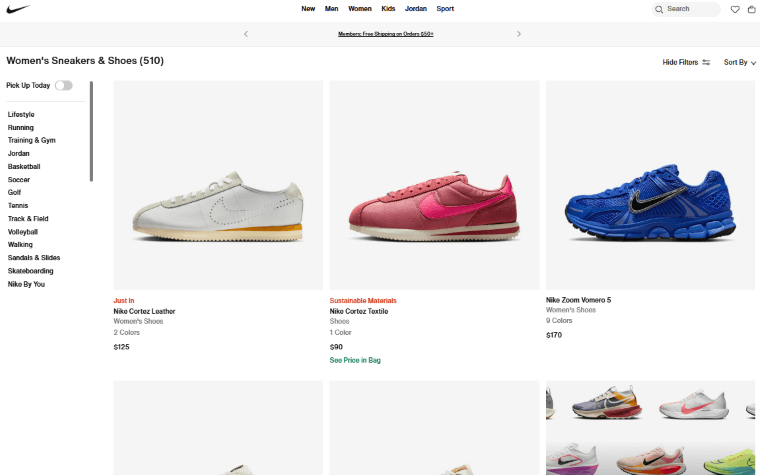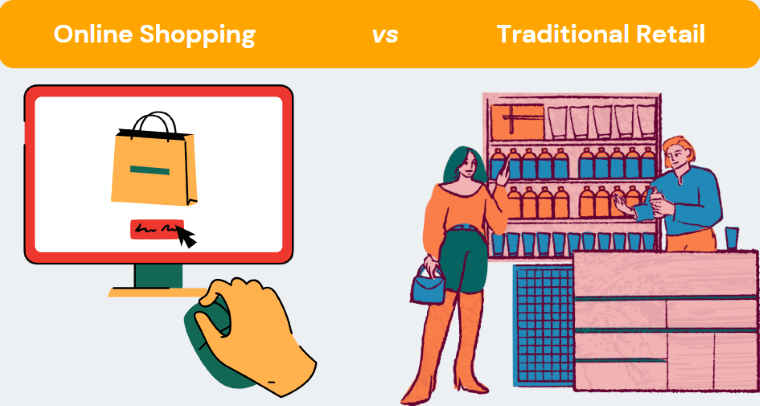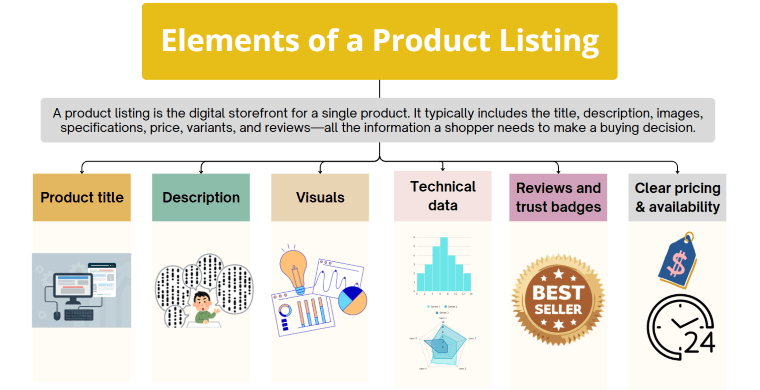How to Create a High-Converting Product Listing for Dropshipping Success in 2025

In 2025, competition in the dropshipping space is fiercer than ever, and your product listing might be the single most powerful asset you control. No matter how great your supplier, how low your prices, or how fast your shipping, one truth remains: if your product listing doesn't convert, you don't sell.
For dropshippers using platforms like Shopify, or WooCommerce, mastering the art of crafting high-converting, SEO-optimized listings is no longer optional. A strong listing does more than just describe your product—it ranks on Google, builds trust, and turns casual browsers into loyal customers. In this guide, we’ll walk you through every key element, from writing irresistible titles and benefit-driven descriptions to using visuals and keywords that drive conversions.
What Is a Product Listing and Why It’s Critical for Dropshippers
- Q: What exactly is a product listing in dropshipping?
- A: A product listing is the digital storefront for a single product. It typically includes the title, description, images, specifications, price, variants, and reviews—all the information a shopper needs to make a buying decision.
In the world of e-commerce and dropshipping, your product listing is the first point of contact between your product and a potential customer. It’s not just content—it’s a sales tool, a search engine asset, and a trust builder rolled into one.

Unlike traditional retail, where buyers can touch or try a product, online shoppers rely entirely on what they see and read. That makes your product listing the only chance to persuade them. A compelling listing can increase click-through rates (CTR), lower bounce rates, and dramatically boost conversions—even when your product isn’t unique.

In saturated dropshipping markets where multiple sellers offer similar products, a well-optimized product listing becomes your key differentiator. It’s how you stand out without lowering prices. A clear, benefit-driven description, paired with strong visuals and trust signals, can position your store as more credible and customer-friendly than competitors.
Simply put, for dropshippers, a product listing isn’t just a formality—it’s a strategic weapon for generating traffic, building brand equity, and converting interest into revenue.
What Are the Essential Elements of a High-Converting Product Listing
A compelling product listing does more than display an item—it persuades potential buyers to act. This requires a combination of key elements working in harmony.

1. Product Title
Your title should be short, keyword-rich, and laser-focused on what the customer is searching for. Skip the filler—focus on precision and relevance to boost search rankings.
Detailed tips on crafting high-converting product titles are just below.2. Description
Go beyond features. Use benefit-driven language that speaks to the buyer’s needs and pain points. Break content into easy-to-read sections with bullet points or bolded highlights to boost readability.
Scroll down for practical tips on writing compelling product descriptions.3. Visuals
Quality visuals sell. Include high-resolution photos from multiple angles and product videos where possible. Incorporating lifestyle imagery allows customers to envision using the product, creating a stronger emotional appeal.
See the section below to learn how to use visuals that convert.4. Technical data
Don’t let uncertainty get in the way of conversions. Provide accurate specs—size, color, material, weight, and available variants. This not only builds credibility but also lowers the likelihood of returns.
5. Reviews and Trust Badges
Social proof is a game-changer. Display verified customer reviews, star ratings, and security or authenticity badges to build credibility instantly.
🔗 How to Use AliExpress Reviews Effectively
🔗 Turn Negative Reviews into Positive Experiences
6. Clear Pricing and Availability
Make pricing transparent and display real-time stock availability. A seamless user experience removes hesitation and encourages quick decisions.
🔗 Explore 8 Proven Pricing Strategies

|
Adapt Your Product Prices Automatically DSers Automatic Pricing - Pre-set Pricing Rule to mark-up your product price automatically |
In short, a winning product listing is part SEO, part storytelling, and 100% focused on user experience. When optimized correctly, your listing transforms page views into actual sales.
How to Craft Product Titles That Drive Clicks and Boost Google Rankings
When it comes to crafting a high-performing product listing, the product title is your first—and often only—chance to grab attention. A well-optimized title not only improves your Google rankings but also drives clicks and conversions. Here’s how to get it right:
1. Start with Target Keywords
Start your title with the main keyword. Early placement helps with both visibility and SEO performance. For example:
✅ "Organic Dog Treats – All-Natural Snacks for Small Breeds"
❌ "Tasty and Healthy Snacks – Organic Dog Treats for Small Breeds"
This helps your product listing appear more relevant in search results, especially for mobile users who may only see the first few words.
2. Add Descriptive Modifiers
Modifiers such as “portable,” “for kids,” “eco-friendly,” or “reusable” help specify your product and reach niche audiences. These descriptive terms improve search match quality and appeal to buyer intent. For example:
“Eco-Friendly Water Bottle—BPA-Free & Leakproof for Travel”
Such clarity builds trust and communicates exactly what your product offers.
3. Include Emotional or Situational Hooks
Beyond facts, your title should evoke a reaction or show relevance to a buyer’s life. Phrases like “perfect gift for moms” or “must-have for hikers” create emotional connections. For instance:
“LED Night Light – Soothing Glow for Baby’s Nursery”
“Best Gift for Pet Lovers – Custom Paw Print Keychain”
These touches make your product listing not only discoverable but also desirable.
4. Keep It Natural—Avoid Keyword Stuffing
Yes, keywords matter, but readability trumps repetition. A title jammed with too many keywords looks spammy and deters buyers. Google’s algorithm also penalizes keyword stuffing. Instead, focus on clarity:
✅ "Stainless Steel Travel Mug – Insulated & Spill-Proof, 16oz"
❌ "Travel Mug Stainless Steel Travel Coffee Mug Insulated 16oz Spill-Proof Travel"
Stick to one or two main keywords and blend them smoothly into a sentence-like structure.
Good vs. Bad Product Titles: What Makes the Difference?
| Aspect | ✅ Good Product Title | ❌ Bad Product Title | Why It Works/Fails |
|---|---|---|---|
| Keyword Placement | "Wireless Earbuds with Noise Cancellation—Bluetooth 5.3 for Running & Gym" | "Bluetooth Earbuds Noise Running Gym Headphones Wireless 5.3" | Good: Keyword at start, reads naturally. Bad: Stuffed, confusing. |
| Modifiers Used | "Eco-Friendly Bamboo Toothbrush—Biodegradable & Soft Bristles for Adults" | "Toothbrush Bamboo Eco Green Soft Biodegradable Dental Oral" | Good: Clear and descriptive. Bad: Jumbled keywords with no flow. |
| Emotional Hook | "Best Gift for Book Lovers—Personalized Leather Bookmark with Name Engraving" | "Bookmark Leather Personalized Engraving Gift Book Reading" | Good: Adds emotional/contextual value. Bad: No narrative appeal. |
| Readability | "Foldable Travel Backpack—Lightweight, Water-Resistant, 25L Capacity" | "Backpack Travel Foldable Water Bag Lightweight Hiking Outdoor Portable" | Good: Structured, clear benefits. Bad: Too broad and cluttered. |
| Relevance to Search | "Gaming Mouse—RGB Wired, Adjustable DPI for PC & Laptop Gamers" | "Wired Mouse RGB DPI Gaming Adjustable Laptop PC Gamer Office" | Good: Targeted audience and features. Bad: Lacks prioritization and clarity. |
How to Write a Persuasive Product Description
Creating a persuasive product description isn’t just about listing technical specs—it’s about showing your customer why your product matters to them. Here’s how to write compelling product descriptions that boost conversions and enhance your product listing:
Emphasize Benefits Over Features
Instead of simply stating what the product is or does, focus on how it improves the buyer’s life. Features are important, but benefits sell. For example:
- Feature: 100% waterproof
- Benefit: Stay dry and comfortable in any weather, whether you're commuting or hiking
Use Scannable Formatting
Online shoppers skim before they read. Use:
- Bullet points for key benefits
- Bold text to highlight essential phrases
- Short paragraphs and plenty of white space to make your product listing easy to read
Address Common Objections
Think like your customer—what might hold them back from buying?
- "Will this fit me?" → Include sizing charts or fit guarantees
- "Is it durable?" → Mention materials, warranties, or customer reviews
- "Is it worth the price?" → Highlight unique value or multi-use functionality
Include a Strong Call to Action (CTA)
Don’t leave the buyer wondering what to do next. Use clear, motivating language:
- "Add to cart now for fast, free shipping!"
- "Order today and experience the difference."
Naturally Integrate Long-Tail Keywords
To optimize your product listing for search engines, include specific, buyer-intent keywords naturally within your description. For example:
- Instead of just saying "headphones," say "noise-cancelling wireless headphones for travel."
- Avoid keyword stuffing—make sure it reads smoothly and still feels persuasive
A well-crafted product description doesn’t just describe—it convinces. By highlighting what matters most to your audience, you turn a basic product listing into a powerful sales tool.
🧾 High-Converting Product Description Template
How Important Are Images and Videos in a Product Listing
In the competitive world of e-commerce, a high-quality product listing isn't complete without compelling visuals. Your words can persuade, but your images and videos prove the value. Here's why strategic titles matter—and how to make the most of them:
Showcase the Product in Use (Lifestyle Images)
Don’t just show the product—show the experience.
- Instead of a plain product photo, display your product in real-life settings.
- A fitness tracker? Show someone using it on a morning run.
- A kitchen gadget? Feature it mid-recipe with fresh ingredients.
Why it works: Lifestyle shots build emotional connection and help shoppers imagine the product in their daily lives—boosting both trust and conversions.
Display Different Angles and Zooms
Customers can’t touch your product online—but you can bring it closer with visuals:
- Upload multiple angles (front, back, top-down)
- Include a zoomed-in image of textures, buttons, or packaging details
- Consider 360-degree views for items like shoes, furniture, or electronics
Why it works: The more clearly a buyer can “see” what they’re buying, the less likely they are to hesitate or return the product.
Use Short Demo or Unboxing Videos
Static images are great—but videos seal the deal:
- Create quick demo videos showing how your product is used
- Record simple unboxing clips to highlight packaging and first impressions
- Add subtitles for silent viewing (especially for mobile users)
Why it works: Videos reduce uncertainty, demonstrate value, and keep users engaged longer—signals that can improve your product listing’s conversion rate and ranking.
Optimize Image Alt Text for SEO
Every image is also an SEO opportunity. Use descriptive, keyword-rich alt text for every visual.
- Instead of "image1.jpg," use: "minimalist leather wallet with RFID protection—product listing front view."
- Integrate long-tail keywords naturally, like “travel-sized toiletry organizer bag for women”
Why it works: Alt text improves accessibility and helps search engines index your images, bringing in traffic through Google Image Search and improving overall SEO for your product listing.
Think like your buyer. Every image or video should answer a question or remove doubt. Ask yourself: If I were shopping for this product, what would I want to see?
By combining lifestyle visuals, detailed images, videos, and optimized alt text, your product listing becomes more than just informative—it becomes irresistible.
How Often Should You Review and Update Your Product Listings
Your product listing should never be a “set it and forget it” asset. To stay competitive and relevant, regular reviews and updates are essential. Here’s when and why you should refresh your listings:
1. Seasonal Updates
Holidays, back-to-school season, or viral trends can dramatically shift buying behavior. Updating your product listing to reflect seasonal demand—whether through copy, images, or promotions—helps you stay relevant and boost conversions.
2. Performance-Driven Updates
If a listing has low click-through rates (CTR), high bounce rates, or low conversion rates, that’s a red flag. Use performance data to identify weak listings, then experiment with new titles, visuals, or feature highlights to increase conversions.
3. Keyword & SEO Shifts
Search trends change. Conduct regular SEO audits to ensure your product listing still includes relevant keywords. Tools like Google Trends or DSers’ built-in SEO tools can help you track these changes and optimize accordingly.
4. Image and UX Refresh
Visuals age quickly. If your images or layout feel outdated compared to competitors, it’s time for a refresh. A modern, mobile-friendly product listing with high-quality visuals builds trust and encourages action.
Conclusion
Your product listing is your digital salesperson—working 24/7 to attract, convince, and convert. To stay competitive, treat listings as ongoing assets: test, refine, and improve continuously. Tools like DSers can help you manage and optimize at scale.
Take action today: Choose one product listing and audit it. A clearer title, sharper benefits, or better visuals could instantly boost your results. Let your product listings sell—so you can focus on scaling your business.









 Company
Company
 Why Choose DSers
Why Choose DSers
 Blog
Blog
 Help Center
Help Center




 Live Chat
Live Chat